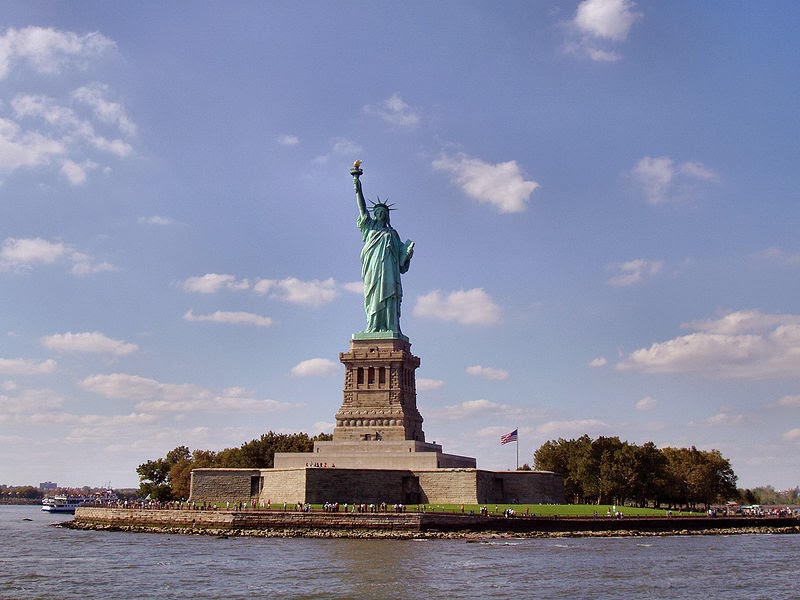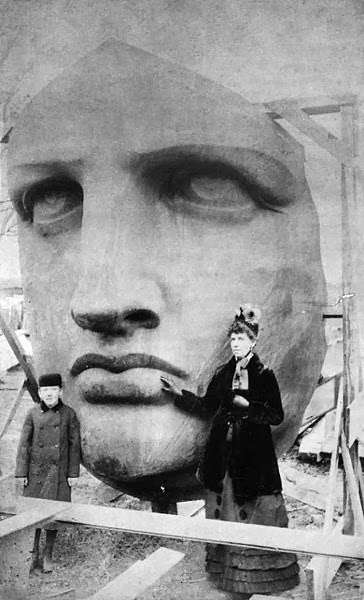
The Statue of Liberty
On October 28, 1886, U.S. president Grover Cleveland, the former New York governor, presided the dedication ceremony of the Statue of Liberty, a gift to the United States from the people of France.
Origin
It is not really clear, what the origins of the Statue of Liberty really were. Sculptor Frédéric Bartholdi once stated that he got inspired while staying at a dinner party with Édouard René de Laboulaye, who was back then a famous author, politician, professor and anti-slavery activist. He is supposed to have said that “if a monument should rise in the United States, as a memorial to their independence, I should think it only natural if it were built by united effort—a common work of both our nations.” Bartholdi immediately started drawing sketches but did not show them to Laboulaye right away. With the ending of the Franco-Prussian War however, Laboulaye and Bartholdi decided to gather some ideas and travel to the U.S. in order to discuss it with the government.
Design
The next step was the design of the statue. The two Frenchmen tried to inspire themselves from earlier symbols of liberty in France and the United States. Both preferred a fully dressed female, since a previous half-clothed Liberty figure stood as a symbol during the french Revolution. It was clear that the statue was supposed to look peaceful and the torch would represent progress. The crown with its seven rays would stand for “sun, the seven seas, and the seven continents”. The sculptor planned simple and bold contours, rather classical. In the statue’s left hand, Bartholdi decided to place a keystone-shaped tablet to emphasize the the role of law. It was inscribed with “JULY IV MDCCLXXVI” he date of the Declaration of Independence in the U.S.

Unpacking of the head of the Statue of Liberty, which was delivered on June 17, 1885.
Liberty Enlightening the World
In 1875, the project was officially announced with the title “Liberty Enlightening the World” and in France the project was met with a great support that also became financial. Even schools and ‘regular’ people started fundraisers instead of just the expected elites. In May 1876, construction work started and Bartholdi began with the arm carrying the torch as well as the head. As soon as the arm was finished, it was transported to the Centennial Exhibition in the United States where it was a popular exhibition object. The arm stayed in the U.S for several years until it came back to France where it joined the rest of the statue. The statue’s head was exhibited at the 1878 Paris World’s Fair and in 1880, Gustav Eiffel joined the project.[4] With the help of the famous engineer, the statue became one of the earliest curtain wall constructions that is mostly supported by the interior framework. In 1885, the statue was finally ready to be disassembled and made ready to travel across the ocean.
In the U.S. the building of the statue faced some criticism at first. It was not designed by an American and it did not show a realistic heroic symbol from the American history, but later on the people of America turned out to be quite supportive. Once the American fundraisers were finally successful and the pedestal was built, the statue began to rise. On the afternoon of October 28, 1886, President Grover Cleveland presided the dedication ceremony of the Statue of Liberty. Ironically, during the ceremony, only two women were allowed since organizers feared, women may be injured in the masses of people.
The History of the Statue of Liberty, [8]
References and Further Reading:
- [1] Statue of Liberty National Monument at National Park Service
- [2] Statue of Liberty at Structurae
- [3] Made in Paris The Statue of Liberty 1877-1885
- [4] Gustav Eiffel and his famous tower, SciHi Blog
- [5] The Hyperbolic World of Vladimir Shukhov
- [6] John A. Roebling – The Father of the the Brooklyn Bridge
- [7] The Statue of Liberty at Wikidata
- [8] The History of the Statue of Liberty, Liberty Treehouse @ youtube
- [9] Bell, James B.; Abrams, Richard L. (1984). In Search of Liberty: The Story of the Statue of Liberty and Ellis Island. Garden City, New York: Doubleday & Co.
- [10] Harris, Jonathan (1985). A Statue for America: The First 100 Years of the Statue of Liberty. New York City: Four Winds Press
- [11] Khan, Yasmin Sabina (2010). Enlightening the World: The Creation of the Statue of Liberty. Ithaca, New York: Cornell University Press.
- [12] Map View of World Heritage Sites in the United States via DBpedia and Wikidata





